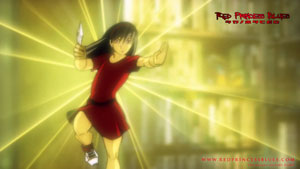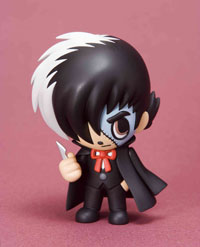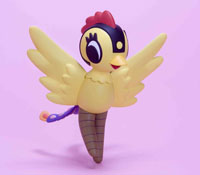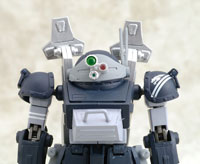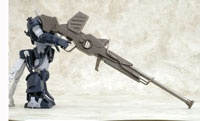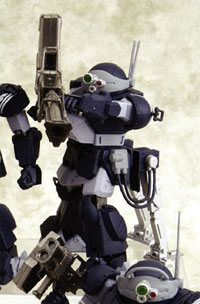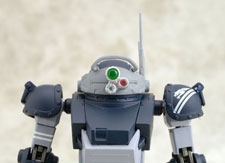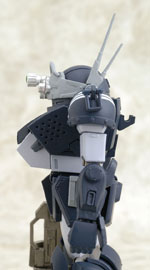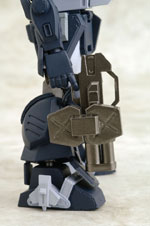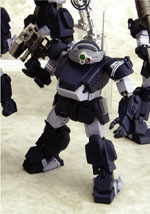 Logo handmade by Bannister
Column by Scott Green
Logo handmade by Bannister
Column by Scott Green
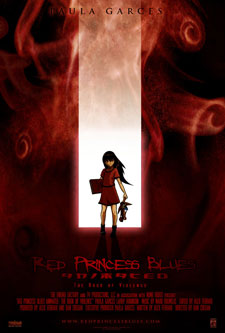
Indie Animation Spotlight: Princess Blues Animated: The Book of Violence
The Book of Violence is an animated short, between six and seven minutes sans credits that serves as a prologue to Alex Ferrari’s upcoming feature film Red Princess Blues. The film is set to star Paula Garces, whose voice drives this animated project. Though there is a stated intention to pay homage to the great Japanese anime films of the past, an immediate impression suggests more North American initiatives, such as the Maxx, the animated Spawn, and the Do the Evolution music video. It has a rain soaked weight of dark, American comics and the surreal sense of noir gloom found in their animated adaptations. In the anime vocabulary, the closest comparison would be early digital aged late night fare, like Serial Experiments Lain, Boogiepop Phantom, and even to some extent Black Heaven. Book of Violence's effects aren't quite as raw as those early titles, but is has a similar, claustrophobic stillness in its 3d objects, and the short itself has that late night anime tension. This atmosphere works for the short, which is definitely more a prologue than a prequel. After a violent incident, Princess, a 12 year old girl who picked up some troubling philosophy and skills from her father, finds herself shipped off to "The Tainted Novel", an old bookstore run by the stern Nino. Maybe it's reading too much into the space, but it feels like there is a trick to this short, open ended story. Between insistences and inconsistencies in what the character says, there are some notes of an unreliable narrator. Almost Dexter-esque in some respects, she's childlike sometimes, especially as she clutches her stuffed rabbit, she sometimes glib, she's sometimes poetic and sometimes hard and decisive. This uncertainty is intriguing enough to generate some serious curiosity about the live action film.A trailer can be seen here
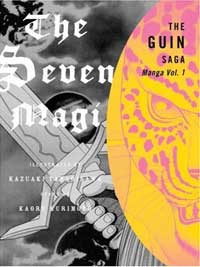
Manga Spotlight: The Guin Sage; The Seven Magi: Volume 1 Illustrated by Kazuaki Yanagisawa Story by Kaoru Kurimoto Released by Vertical, Inc.
Vertical has been releasing the opening books of Kaoru Kurimoto's 100+ fantasy epic, the Guin Saga. The first novel was reviewed here, and what was most impressive about the work was the fluid rush of its narrative. Kurimoto sprinted between moments of crisis without dropping an edge of critical importance. This drive is bolstered by the gritty spirit of his fantasy world. The series is credited as an inspiration for Kentaro Miura's Bersek, and Miura's specter of swords against an unforgiving, deadly world definitely finds an antecedent in Guin Saga. The cycle starts with the uber-warrior Guin waking up with a panther mask affixed to his face and no memories other than the knowledge of living and fighting. The Seven Magi manga series is a gaiden/side story from some later, King of Aquilonia phase in the mythology of this accomplished warrior. Having read the novels that Vertical has released undoubtedly has some value, but it's not essential, and if you've read all of what has been translated, it still seems far up the road from where Seven Magi starts. Guin is traveling as the king errant of Cheironia. As he moves, cloaked through a city that seems to pull its design both from middle ages Europe and Arabian Nights, he's confronted by the devastation of a "Black Plague" that is evidenced by bodies being heaped in pyres families going Elizabeth Báthory on each other in hopes of curing themselves by bathing in blood and dark beings haunting the streets. There's plenty that can be said in favor of Guin's Saga's ramming speed style, but it is also a pin-ball narrative. As Guin goes off the bumpers, he picks up an entourage including a cut throat, a dancing girl, and a magus whose head and body aren't exactly in one piece. In most respects, Seven Magi is not going to compare favorably to Berserk, but world and atmosphere aside, the intensions don't match. It's a short (three volume), punchy block in a larger framework that seems devoted to full-on action sequences. Berserk has developed an expectation that its bloody drama will continue to carve into its hero, Guts. The hyper-competent Guin is more of a wandering figure like Kenshiro ( Hokuto no Ken/Fist of the North Star. Which isn't to say that he's a Golgo 13 cipher, just that King Guin of Seven Magi and the Guin who is desperately in need of food and water in novel 1 don't seem radically different. . While the character will continue feeling the slings and arrows of his tribulations, his scars are in the past. The situation may continue to change around him, but, as a person he seems formed. Artistically, Kazuaki Yanagisawa is no Miura. He's not really a known name in North America, but he's produced other manga of note.. His Shin Megami Tensei (KAHN), Persona spin-off is due out from TOKYOPOP early in 2008. He also handled the art side of Kazuo Koike's Paparazzi. Here, he displays a very genre suited style. There tends to be something funky in his proportions, with characters that are either stubby or gangly, but his stacked women and super-hero proportioned Guin certainly set an agenda for the manga. That bawdy figure work is enhanced with a lunatic over-extension to the characters' expressions. While it is not quite serious, it is interesting to look at. Yanagisawa is effective in his layout of buildings, especially when using them as a fighting arena. Like a kung fu movie, he'll set a fight in an alley, and let Guin and his monstrous adversary run up the walls, leap onto overhangs and the like. While he might not be rewriting the book of monsters, and the novels have produced some far odder creations, there is an insanity to Seven Magi's monsters that is worth appreciating. We probably will never receive Go Nagai's Getter Robo manga in North America, so it's nice to have Guin Saga's giant, demonically horned t-rex dinos thundering around. For fans of guy manga, Seven Magi is a bit of a treat. Vertical applying their work to manga that is pulp, without the artistic gravity of a Tezuka or Takemiya title is certainly gratifying. It's even more worthy of a little thanks considering that manga for older male audiences have largely been nudged out of the market. Like the novel, the Guin Saga manga is twitchy without being addled, which makes for a nice, caffeinated experience.
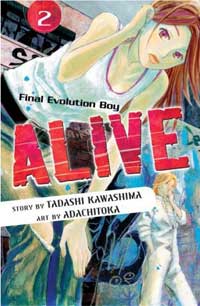
Manga Spotlight: Alive: The Final Evolution Volume 2 Story by Tadashi Kawashima Art by Adachitoka Released by Del Rey
Volume 1 of Alive tried to be a heavy existential horror, and ended up looking like Suicide Circle/Jisatsu Saakuru with magic marker lines in place of scars. With apparent shounen roots, such as a spunky, headstrong guy with a cute childhood friend and a sexy older sister, the manga seemed to be unwisely fighting up a weight class. Volume 2 flips the issue. Structurally, it's decidedly shounen material, with a gathering of forces, the hero and his uneasy, newly acquired allies on one side, a cadre of adversaries and their agents on the other. Yet, this one works. It's quirky. It's appreciatably serious and appreciatably goofy. It's not some blood drenched, forcefully obscene seinen manga, but it is an interesting shounen title with some credibility and a handle on some weighty issues. In the first volume, Taisuke Kanou, an orphan raised by his sister, received a strange signal that felt like it was coming from outer space. Most of the others who had this experience killed themselves after feeling an overwhelming wave of thanatopsis. Those who didn't kill themselves began killing others who they deemed beneath them. One of these was Taisuke's bullied friend Hirose, who seems to have killed a number of tormenters, and then disappeared with Taisuke's girlfriend Megumi. After a run in with Takumi Yura, a crazed, unwashed, caricature of a serial killer, who picked up the ability to rip people apart with soap bubbles, Taisuke decided to hit the road in order to find Megumi and Hirose, and do it some place far away from endangering the other people he cares about. At least for this volume, the resulting format sees Taisuke traveling, meeting people who shared his experience. Some of these people fight him and decide to join him, others fight him and persist in their efforts to kill him. The travel, meet and fight routine is a bit like Jojo's Bizarre Adventure (the famous third part, which has been released in North America), except it's through the byways of Japan rather than the globe, it features a Naruto/Luffy figure who is goofy, honest, earnestly heroic rather than a cold glam/macho guy, and the conflicts are generally settle through intentions and emotions (rather than Jojo's, believe it or not, intellect). The difference between this volume and the first is that it takes the time to develop the tensions and danger. Rather than just opening a vein, pointing at the arterial spray and proclaiming "look... heavy?!?", the situation is allowed to sink in and affect the people on scene. With suffocating, invisible boxes and eviscerating bubbles, the manga has earned its sense of danger. It isn't the most profound meditation on mortality ever, but it doesn't need to be, and this time around, it does establish some moving moments.
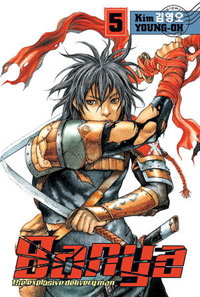
Manhwa Spotlight: Banya: The Explosive Deliveryman Volume 5 By Kim Young-Oh Released by Dark Horse Manhwa
Personally, I have no sense of direction or ability to spot where I should be going. I make it a point to be punctual, but even if I leave early, when traveling to a place outside by typical slate of destinations, I'll invariably end up arriving significantly late. I get the sense that Banya was scripted like one of my travel paths. Lots of needless circling, followed by a wacky short cut to the destination. In this case, Banya's ragged path looks like it was shaped by less than stellar planning and by difficulties in its initial publication/serialization. The strength of Kim Young-Oh's illustration is such that Banya is still a thoroughly immersive, engaging fantasy manhwa, but if it didn't have a middle full of small one-off stories and an end that quickly goes from naturalistic low tech with fantasy fauna to high fantasy to legendary to cosmic, the title could have been staggeringly good. The eponymous Banya has left his old delivery partners behind to bring the monster summoner Jiahn to Mordor...err the Land of Death. Invoking "Mordor" is not merely being snarky. Kim Young-Oh is an amazing, imaginative monster designer. The scale and organic construction of his work ought to earn him a role in the movie industry. Yet, he also wears his influences on his sleeve. The war with the orcs angle to the series wasn't carried into this final volume, but he still prominently features references to the Lord of the Rings movies. So, Banya, who has recently begun showing uncontrollable murderous rages, owing to a suitably tragic childhood, Jiahn, and the mysterious swordsman Muah hit the final leg of their journey, contending every more numerous monsters and the vicious trackers of Kamutu along the way. It's an exciting conclusion, but the five volume journey has been something of a triathlon. We've swum through a Helm's Deep meets Musa the Warrior introduction with Banya delivering messages between outposts on a largely desolate landscape, then biked through more conventional, fantasy short episodic stories, and now, ran through the big, motivation milestones. That all leads to a finale that is a nice bit of myth making, but awfully tangential. And it is unfortunate that Banya is lessened by this lack of a coherent arc, because Kim Young-Oh really lets loose in this finale. There was one case where he presented a goofy take on his monster design, and that stands out because it was one of the rare exceptions where the creatures were not painstakingly rendered. For the finale, the Land of Death is crawling with old favorites and a few new nasties. The site of herds and flocks of these creatures is about as big and impressive as fantasy comics gets.
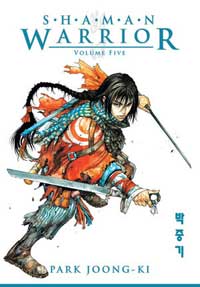
Manhwa Spotlight: Shaman Warrior Volume Five By Park Joong-Ki Released by Dark Horse Manhwa
Following on the heels of volume 4, 5 still seems to be putting pieces in place. Some writers seem to struggle with the phase of a story in which characters have to exit for years to train. George R. R. Martin needed a major rewrite of the middle books of his A Song of Ice and Fire series of fantasy novels after finding that he could not elegantly shape his narrative around the five year leap he had in mind. Early volumes of Shaman Warrior established that its principal characters were real demons in the fighting arena. Then, it needed an, at the time, very young character to join the seasoned warriors. Bringing the subject from a gentle child to a hardened, hyper-competent badass hasn't been a dull process to follow. Park Joong-Ki didn't write the phase of the story off as a necessary evil, and his wasteland, martial arts school of very hard knocks has had a hefty impact to it. However, coming after the solid, knock-out power of the fight scenes of the series' third volume, this two volume stretch has felt deliberately restrained. Yet, that's like comparing Snake and Crane to Drunken Master. Even if it suffers in comparison, it still stands out as incredible. Yaki, the daughter of the shaman warrior Yarong, who was named as a threat to his nation and killed as part of a purge, is now an active player in the action. After spending her formative years in an infernal camp for assassins, she's now a regular wushu Sweeney Todd with a short blade. By the end of the volume, she, her absent "Butcher" guardian Batu, and the young, revenge seeking shaman warrior Horakaan, are uneasily reunited, more or less working together. What continues to be amazing about Shaman Warrior is that its fight scenes are not simply place holders or short hand and not merely special within the context of the fiction. Part of it is that the warriors fight dirty and cut deep. The intention isn't to showcase the gore, and this isn't work for which brutality is an explicit goal, but if someone is taken down and almost brained with a rock, Shaman King is sure to capture it in a manner that is dusty, and physical. If that is the side that ensures that the reader knows that the combatants mean business, the other side of the equation is the "wow" moments. These are strings of attacks that one could, in theory, do if they had the training and presence of mind in the midst of a fight. In those cases, what's truly impressive about Shaman Warrior is Park Joong-Ki's imaginative choreography: two people pair off, swinging swords, throwing objects for distraction, launching sudden kicks. You'll wish other comic artists thought through their action so thoroughly. And, the "wow" comes from the shaman warrior current in Shaman Warrior: feats captured with some sense of physical bounds, but teetering on the line between amazing and expressly incredible. When Yaki does her Assassin’s Creed parkour routine mid-volume, as much as you appreciate the spectacle of what she's doing, you have to appreciate that Park Joong-Ki pulled of the speed and bounce in this medium. Shaman Warrior is THE comic that a fight spectator should read. MMA fans, this is the comic for you. Kung fu/wushu movie watchers... bingo There's a lot to be said for the ballsy fighting manga like Baki The Grappler, Tough and Shamo, and Shaman Warrior doesn't have the same punch you neighbor vicarious rush. But, in terms of the spectacle of two people really trying to inflict serious damage on each other through means that are a lot more personal and involved than pulling a trigger, nothing comes close to Shaman Warrior.
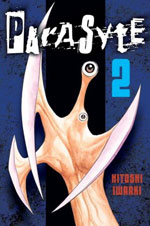
Manga Spotlight: Parasyte Volume 2 by Hitoshi Iwaaki Released by Del Rey
Few manga handle the presentation of a shocking event as well as Parasyte. This series is full of them. The world is turned upside down, then sideways. Yet, these attacks on the normal never become expected and never loose their edge. Part of the reason for this is that the manga's hero is eminently normal without being flat, underdeveloped or boring. He's an every-person teen who went to sleep with his headphones on and slept through the alien invasion. Rather than the spore crawling into his ear and borrowing into his brain, the creature replaced his hand. Shin and his symbiotic hand/alien Migi find that they have to work against the world. Even though a disturbing quantity of people have been turned into hosts for aliens and though these aliens have been consuming a large number of secondary victims, humanity doesn't seem equipped to comprehend, let alone deal with the predicament. Nor does Shin/Migi's status as a failed hybrid win them any points with the aliens, who prove to be a coldly biologically driven, unsentimental race. The approach of volume 2 of the manga is to throw a few "made you flinch" feints, then land a real haymaker. Several times, it does something that is surprisingly irreversible. The approach is a bit more organic than the horror movie convention using definitive cast that can be whittled down. Everyone is fair game. The hero himself is not going to die, but that doesn't mean that the experience will not change him. Fans of old John Carpenter, Slither, Gremlins and the like will find a wellspring of that 80's horror combination of menace and opportune comedy. The manga recognizes the line between frightening and laughable, then consciously dances between the points. It never distracts from a moment that needs to be critically serious with an inserted joke, and it recognizes how to exploit the boundary between funny and unsettling. In particular, the volume features a number of moments with Shin and other hybrids that are both funny and upsetting for what they demonstrate in losing the ability to control one's own body.
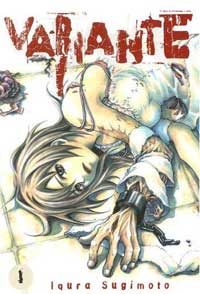
Manga Spotlight: Variante Volume 1 By Iqura Sugimoto Released by CMX
One of the traits that has made the manga tradition stand out and grab the attention of North American media consumers is its willingness to mix tones within a given work. From Neon Genesis Evangelion to Tenchi Muyo to Fushigi Yuugi, the anime and manga that was headlining the boom, and later through popular works like Full Metal Alchemist and Naurto demonstrated a willingness to rapidly shift gears, evolve and surprise. Variante doesn't automatically wander off a ledge by trying to mix gut-punch splatter horror with wide-eyed goofiness. It does get into trouble trying to convey a gravely serious tone with characters that unpredictably becomes cute caricatures. If the intention was to cast the heroine as a vulnerable, big hearted girl whose disposition is entirely at odds with her circumstances, and her allies as relatively cool/sympathetic professionals in a world of unfeeling adults, the results were disorienting shifts in tone and an imprecise command of manga storytelling. This first volume of the series does have a few scenes in which the violence is devastating, but the scenes of overplayed glibness stand out almost as much as the shocks. Aiko was a regular girl, whose semi-distinguishing characteristic was that she played the piano. For the most part, her motivation for learning and practicing was to make her parents and friends happy. But, her life was shattered when she walked in on her parents' violent death. After almost being autopsied, when a pulse was discovered, Aiko was transferred to a lab where her mangled left arm miraculously began to regenerate. The world just gets more sadistically perilous for Aiko from there. She learns that her arm has been infected by DNA from a chimera, that these shambling monsters are after her, and that they represent a threat to those around her. She's also confined and told that she's a suspect in the death of her parents, perhaps for good reason, because her infected arm has demonstrated the ability to viciously lash out on its own. The young maverick investigator (as demonstrated by his flamboyant head-band) Agent Sudo and researcher Kochigawa demonstrate that they are sympathetic to Aiko, but the powers that be at Atheos Labs put it in no uncertain terms that Akio can either hunt chimera for them as their combatant or be destroyed as a threat. With Akio, chained like a monster, sent out like a suicide soldier and witness to the violent death of various people she cares about Variante has a vicious meanness to it, but not necessarily more than that demonstrated by accomplished thrillers. The scenes of Akio being locked up and the results of a person crossing paths with a chimera are effecting. The problem is that outside the heat of the moment, Variante will offer pages of Akio looking around with puppy dog eyes or Sudo cartoonishly kicking reporters to the curb. The manga seems to rein in these dipolar tendencies as it progresses. It has some identity work to cement going forward, but if it can stop undercutting itself with attempts to make the characters loose and likable, and it has someplace intelligent to take what is presumably going to be a conspiracy chase scenario, then Variante could become a compelling, pitch black suspense manga.
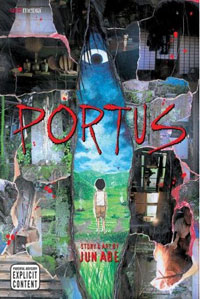
Manga Spotlight: Portus By Jun Abe Released by VIZ Media
Either Jun Abe labored intensely to try to make Portus work or he enjoyed throwing everything he could think of at the topic, because this is just about the least economic you can get in horror manga without running into Go Nagai/Takayuki Yamaguchi territory. In "J-Horror", David Kalat presented the idea that The Ring and its ilk of "dead wet girl" horror movies were works of an artistic school. While you might need some art appreciation to spot someone who is just aping an impressionistic style, it is easy to spot when a "dead wet girl" story that fails to coalesce. Again, there is too much attempted to suggest that Abe is doing hack work, but Portus really suffers for lack of a credible, consistent philosophy. The shame is that Abe demonstrates strong visual notion how to capture that style of movie making in manga. The titular Portus is the video game version of the VHS tape from The Ring. It's an old game, and legend has it that if you get to a certain level, a little boy would appear and ask you "do you want to come to this side?" If you said yes, you would die. (The video game lore is pretty fuzzy. While the game itself looks like it’s from the Atari 2600 epoch, the console looks like a Famicon box). Put in a cursed Kokeshi, traditional peg doll and family trauma, and there is way too much going on. The ideas bump into each other rather than coexist, as if Abe was working from every direction at once. Maybe there is an effective story that can be told through video gaming that doesn't seem like it was plucked as an alterative Ring-like vector, but Portus isn't the horror that gamers might hope for. If Abe can't handle any of these different story aspects, he can perfectly handle the diverse of range visual facets. The game itself isn't anything special, but the victims, their visions, and the imagery behind the cause of the haunting is all nightmare-inducing material. There is a tangibility in Abe's work, as if he was sketching something in front of him. This makes a close up of a face looking down, panicked at a cell phone disconcerting; a bit too close to someone who is too close to a brittle state. It makes a school girl's room turned into a news-paper plastered serial killer nest worrying. And, more otherworldly sights, such as a person turned into a bound-wooden doll or almost Paprika-esque person/landscapes, into memorable horror tableaus. Apart from notable exceptions (Death Note recently) manga is generally the work of a single writer/artist (with assistants, editors, ect). But, if Abe could be paired with a horror writer, they could produce be superbly creepy, modern horror manga.
Upcoming in Japan
AnimeNation notes that the official Japanese Hellsing OVA homepage has revealed that the fourth episode of the ongoing series will be released in Japan on February 22, 2008. The next Japanese Hokuto no Ken ("Fist of the North Star") OVA, Shin Kyuseishu Densetsu Hokuto no Ken Toki Den (New Savior Legend Fist of the North Star Toki Story) is now scheduled for March 26, 2008. A Golgo 13 anime is in the works for Japanese TV next year. Moe mecha-girl (military planes) Strike Witches will be getting a manga series, and maybe a TV anime on '08. GTO creator Tohru Fujisawa's new manga Animal Joe started in the latest issue of Shogakukan's Big Comic Spirits. Takuya Fujima's Negima!? neo spin-off will be coming back in Magazine Special No.2 , on sale January 19th. From Anime News Network, a trailer of Gag Manga Biyori 3 is online. (In the linked page, select the center red button that has "PV" in it.) Akitaro Daichi (Kodocha, Fruits Basket, Animation Runner Kuromi) returns for the latest adapation of Kousuke Masuda's Gag Manga Biyori manga. 15-second and 30-second commercials of the adaptation of Ryo Amamiya's light novels Shigofumi is online. The anime features the work of director Tatsuo Sato (Martian Successor Nadesico), script supervisor Ichiro Okouchi (Code Geass: Lelouch of the Rebellion), and original character designer Kouhaku Kuroboshi (Kino's Journey). A trailer for Sguy and The Family Stone the Movie, scheduled for February 16, can be seen here A third Hell Girl series, the first of which is being released in North America by FUNimation, is now being produced for Japanese TV. Reiko Shimizu's Himitsu - Top Secret philosophical science fiction suspense manga will be animated for a Spring 2008 television broadcast. Genshiken Hainyu Ranjin no Yabo~Return of the OTAKU~, a prose spin-off to the Genshiken geek comedies will be published by Kodansha's KC Novels imprint on January 23. Manga creator Shimoku Kio contributed the cover. According to Comipress Kendi Oiwa, illustrator of the manga versions of Welcome to the NHK and Goth will start a new manga called Yume-Watari Pulcinella, which will debut in the next issue of Monthly Shonen Ace. A one-shot titled Urooboe Uroboros by Ishin Nishio (story) and Death Note artist Takeshi Obata will appear in Shueisha's Weekly Shounen Jump No.6-7 (1/4). On the flip side, Kozue Amano's pastoral sci-fi Aria will end its serialization in Mag Garden's Comic Blade in early 2008. The third season of the anime will start next year. Makoto Raiku's Konjiki no Gash!!/Zatch Bell is coming to an end in Shogakukan's Weekly Shounen Sunday .
Figures News
Organic Hobby, Inc will be releasing Tezuka Moderno Labo 3" PVC figures of Osamu Tezuka's Black Jack and Phoenix in February for $9.50 each. "Black Jack," is a fictional character originated from the manga with the same name "Black Jack" written by Osamu Tezuka in the 1970s. The character "Black Jack" is a medical mercenary, selling his skills to the highest bidder. The manga consists of hundreds of short, self-contained episodes, on the order of 20 pages of manga each. "Black Jack" is 3" tall PVC figure and comes in a clear box. The figure has a swivel joint located at the neck."Phoenix," is a fictional character originated from the manga with the same name "Phoenix" written by Osamu Tezuka in the 1970s. Tezuka considered Phoenix his "life's work"; it consists of 12 books, each of which tells a separate, self-contained story and takes place in a different era. Each story generally involves a search for immortality, embodied by the blood of Phoenix, an eponymous bird of fire, which, as drawn by Tezuka, resembles a peacock. The blood is believed to grant eternal life, but immortality in Phoenix is either unobtainable or a terrible curse, whereas Buddhist-style reincarnation is presented as the natural path of life. "Phoenix" is 3" tall PVC figure and comes in a clear box. The figure has a swivel joint located at the neck. Other February Organic Hobby, Inc released include the ATM-09-ST Scopedog (Rane Custom & Bockmesser Custom Vers.), which will be released will CM’s Corporation for $68.00. each. "ATM-09-ST Scopedog (Rane Custom & Bockmesser Custom Vers.)" are based on the famous TV Anime action series "Armored Trooper VOTOM" created by Ryosuke Takahashi and Sunrise, aired in Japan from April 1, 1983 to March 23, 1984 on TV Tokyo. The figures are each 5" tall PVC/ABS/PC and comes with multiple articulation points. Organic Hobby, Inc and Happinet will be releasing Curvature of the Spine - Preneru in February for $80.00 The character "Preneru" is based on the video strategy/role-playing games "Disgaea: Hour of Darkness" and "Disgaea 2: Cursed Memories" for the PlayStation 2 video game console, developed and published by Nippon Ichi in Japan, and published in North America by Atlus Co. and in Europe by Koei. This is the secret character of Disgaea from the Palm Scenery Series. "Preneru" is a 7" tall fully painted PVC figure and comes in a window box with a custom base for display. Yamato USA has announced that they are holding over their holiday sale through January 1, 2008
March Bandai Ent. Releases
Anime on DVD lists that Bandai Entertainment has the following releases scheduled: 3/4 Di Gi Charat Nyo! vol. 6: Fantastic Children Complete Collection ($49.98) Flag vol. 3 Mobile Suit Gundam SEED Collection 2 ($49.98) My-Otome vol. 5 3/18 Agent Aika Complete Collection ( $39.98) Eureka Seven Music DVD w/Bonus CD ($24.98) Eureka Seven vol. 12
Best anime of 2007
Danny Choo has translated the results of Yahoo Japan's best anime of 2007 poll, which reportedly received over 2 millions responses. 1 - sola 2 - Lucky Star 3 - Katei Kyoshi Hitman Reborn 4 - Ookiku Furi Kabutte 5 - Higurashi 6 - Gintama 7 - Nanoha StrikerS 8 - Nanatsuiro Drops 9 - Sayonara Zetsubou Sensei 10 - Hidamari Sketch
Intermixi Offers "How To Draw Manga" workshop by Manga University
Intermixi Japan Tours has announced that their Neo-Tokyo tour will be offering a Manga University workshop from Atsuhisa Okura (author of "Moe USA" and creator of the 10-page manga that appeared in the November issue of Wired magazine) and Saori Takarai (author of "Manga Moodss" and "Manga Sisters"), the people behind the "How to Draw Manga" series. In addition to the Neo Tokyo tour, Intermixi will be offering a Kame Hame Kansai that focuses on the historical side of Japan`s cultural capitals.
GDH Announces P2P Distribution of Animation Titles
GDH K.K. has announced that animation titles produced by its subsidiaries GONZO K.K. (Head Office: Nerima-ku, Tokyo, Managing Director: Junji Fujita, hereafter GONZO) and GONZO Rosso K.K. will be distributed online via P2P* network for a limited period. GDH will provide SPEEDGRAPHER, and a new title to be released in the coming spring, The Tower of Druaga - the Aegis of Uruk -, both of which were produced by GONZO, and Project PAPO produced by GONZO Rosso on its exclusive website using "SkeedCast," a platform for digital content distribution developed by DREAMBOAT Co., Ltd (Head office: Kyoto-shi, Kyoto, CEO: Kei Mima). This venture will serve to evaluate how the utilization of P2P networks can contribute to reduction of server load and costs, and to assess the feasibility of P2P file sharing scheme as a new business model by distributing not only promotional footage but also animation episodes for a fee. The 24 episode SPEEDGRAPHER is selling 1,000 JPY per episode in Standard Definition (1 MB) and JPY 1,500 in High Definition(3MB) The special price prior to Jan. 31, 2008 is JPY 500 in Standard Definition and JPY 750 in High Definition Project PAPO 7 eps, 2.5 minute episodes is JPY 150 in Standard Definition, High Definition or Ultra High Definition (8MB) The Tower of Druaga is a free, streaming trailer
Death Notes News, Mostly Controversy
A Geek in Name Only reports that teens in Tennessee, Virginia and Massachusetts have landed into hot water making lists of people that they'd like to see dead in imitation of Death Note. Via Anime News Network, manga publisher Kodansha Inc. issued an apology for the alleged plagiarism of the Death Note, Air Gear, and MPD-Psycho in Megabaka by Naka Gomura. Two postings on livedoor.biz have collected sample images of the alleged plagiarism from the 2ch bulletin board system Twitch has plenty of media from Hideo Nakata’s Death Note spinoff L: Change the World here
Anime At Boston's First Night
New England Anime Society (NEAS) will be participating in First Night Boston, an all-ages New Year's Eve celebration on December 31st, 2007. First Night Boston activities include arts and cultural performances at venues throughout Boston, and as part of the festivities, the NEAS will be screening anime from 1 PM to 11 PM in the Hynes Convention Center, Room 100. The family friendly First Night anime screening program includes first episodes from anime including Hikaru no Go, Prince of Tennis, Nadia: The Secret of Blue Water, and Tsubasa Reservoir Chronicle. The full scheduled can be seen at firstnight.neanime.org During the screening, NEAS will be accepting in-person preregistrations for its upcoming convention events, Anime Boston and Providence Anime Conference. Coming to the Hynes Convention Center and Boston Marriott on March 21st - 23rd, 2008, Anime Boston is New England's largest anime convention, and First Night Boston marks the last day for fans to register at the $40 rate. First Night Boston will also be the first opportunity to register for Providence Anime Conference (PAC) at the lowest available rate of $65 for the first 250 registrants. The world's first anime convention exclusively created for fans 21 and up, PAC will be held at the Rhode Island Convention Center from October 3 -5, 2008. Both Anime Boston and PAC are independently run by NEAS as part of its mission to further understanding of Japanese culture through various forms of media. Admission buttons for First Night Boston are $15 each and can be ordered online or purchased at selected local retailers. For more information and the full First Night Boston schedule, please visit www.firstnight.org. The First Night Boston button grants admission to all other First Night Boston events and will be required to access the NEAS anime screening and in-person registration.
New Chun Li Cast
Joystiq notes that contrary to initial report that Jessica Biel would be playing the titular role in Street Fighter: Legend of Chun-Li, Kristin Kreuk (Smallville's Lana Lang) has taken the part. Directed by Andrzej Bartkowiak, 20th Century Fox will be distributing the film, which begins filming in Thailand next March.
Worth Checking Out
Same Hat! Same Hat! has a translation for Shintaro Kago's ero-guro short LABYRINTH. Episode 56 of Right Stuf's Anime Today podcast features an interview with Wendy Shimamura – associate product manager for VIZ Media. Shimamura discusses the highlights of VIZ Media’s 2007 anime releases, its download-to-own products and Toonami Jetstream project, next-generation formats, growing the shoujo anime market, the challenges facing the anime industry and what’s coming up in 2008. Production I.G has an Q&A with novelist Nahoko Uehashi about the Moribito novel series here, which Production I.G adapted into an anime. Newsarama talks to DC's Paul Levitz about CMX amoung other topics Publisher's Weekly spoke to Aimee Steinberger about Japan Ai: A Tall Girl's Adventure in Japan From Let's Anime anime journalism circa 1987 Via Japanator, an English language map of the geek mecha Akihabara can be found here Japanator has a preview of next gen games based on Shonen Jump titles here Michael Jackson walks past the manga section From the ComiPress Manga Zombie series, Takeuchi Kanko: The mystery manga artist who spawned a second Kitaro ComiPress lists the 11th Japan Media Arts Festival Jury Recommended Works Anime News Network lists the 31st Japan Academy Prize Nominees Not much to see now, but ComiPress has launched a blog North american adult manga distributor Icarus Publishing is offering a samble issue of the Comic AG Digital anythology free here Pop Culture Shock on NY Anime Fest ICv2 Technology and the Otaku panel. Publisher's Weekly also reports on the panel The Manga Blog on NYAF: ICv2’s Marketing to Girls panel. MangaBlog also collects links Blog@Newsarama talks to manga/comic critic Joe "Jog" McCulloch Queenie Chan on the end of the Dreaming Via Majoria's News, a look at Puchi Eva, the upcoming Neon Genesis Evangelion videogame for Nintendo DS featuring the cute super deformed designs by RyusukeHamamoto.



